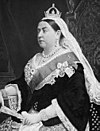User:Matilda/List of monarchs
Rationale[edit]
Further to the comments I made at Wikipedia:Articles for deletion/List of Australian monarchs which in effect supported a List of Commonwealth Realm Monarchs. At Talk:List of Australian monarchs the point was made (among others the various countries over which the British monarchs reign have a simultaneous and instantaneous succession. However there are numerous dates within those reigns that are peculiar to particular realms. My aim is to make a list which highlights the similarities and differences.
Chronology[edit]
This list is incomplete; you can help by adding missing items. |
| Monarch | Reign | |||||||
|---|---|---|---|---|---|---|---|---|
| House of Hanover | ||||||||
| Victoria[1] |
| |||||||
| House of Saxe-Coburg and Gotha | ||||||||
Edward VII 
|
| |||||||
| House of Saxe-Coburg and Gotha (1910-17), then House of Windsor | ||||||||
George V 
|
| |||||||
| ||||||||
Edward VIII 
|
| |||||||
George VI 
|
| |||||||
| Elizabeth II |
| |||||||
References[edit]
- ^ The Canadian Heraldry Society states: "...Her Majesty, Queen Victoria, [was Queen of Canada and all her other realms. Queen Victoria was the first Monarch of the confederation of provinces that became known as the Dominion of Canada on July 1, 1867."
- ^ Zines, The High Court and the Constitution, 4th ed. (1997) at 314: "The Queen as monarch of the United Kingdom, Canada, Australia and New Zealand is in a position resembling that of the King of Scotland and of England between 1603 and 1707 when two independent countries had a common sovereign"; the relationship between England and Scotland during those years is described as a personal union.
- ^ P. E. Corbett (1940). "The Status of the British Commonwealth in International Law". The University of Toronto Law Journal. 3.
{{cite journal}}: Text "pages 348-359" ignored (help); Unknown parameter|Number=ignored (|number=suggested) (help) - ^ F. R. Scott (January 1944). "The End of Dominion Status". The American Journal of International Law. 38 (1): 34–49.
- ^ R v Foreign Secretary; Ex parte Indian Association, QB 892 at 928; as referenced in High Court of Australia: Sue v Hill [1999 HCA 30; 23 June 1999; S179/1998 and B49/1998]
- ^ The English Court of Appeal ruled in 1982, while "there is only one person who is the Sovereign within the British Commonwealth... in matters of law and government the Queen of the United Kingdom, for example, is entirely independent and distinct from the Queen of Canada." R v Foreign Secretary; Ex parte Indian Association, QB 892 at 928; as referenced in High Court of Australia: Sue v Hill [1999 HCA 30; 23 June 1999; S179/1998 and B49/1998]
- ^ Heard, Andrew (1990). "Canadian Independence". Simon Fraser University. Retrieved 2008-04-10.
The legislative confusion which followed the abdication of King Edward VIII in December of 1936 was an important step in the evolution of Dominion status, because it demonstrated that the Imperial Crown could be an entirely divisible entity in law. All the Dominion governments had been warned that the King was about to abdicate the throne; indeed, the Canadian government sent a cable urging him to put his duty as King ahead of his desire to abdicate and marry Wallace Simpson. The news that the Instrument of Abdication had been signed was cabled to all the Dominion governments. Australia's Parliament was in session at the time and gave its formal assent to British legislation, as required by the convention recited in the preamble of the Statute of Westminster. The governments of New Zealand, Canada, and South Africa gave their consents as their Parliaments were not in session; the British Parliament passed an Abdication Act on the following day, December 11th, that gave legal effect to the Instrument of Abdication and brought George VI to the throne.
The divisibility of the Crown became a matter of law in some jurisdictions, however, through the actions of two Dominion Parliaments. The Irish Free State passed an Act declaring that the abdication took effect on December 12th, while the South African Parliament later passed an Act that declared that the abdication had taken effect in South Africa on December 10th. When the Canadian Parliament met in the new year, it passed an Act giving its assent to the British legislation. The assumption of this legislative authority was legally redundant because the British Act was undoubtedly already in force in Canada; it complied with the requirements of s.4 of the Statute of Westminster by containing a reference to the fact that it was being enacted with the request and consent of Canada, and a proclamation announcing that the accession to the Throne had also been duly made by the Governor General. But as Clokie observed about the Canadian Act, "Whether necessary or not, it was clearly designed to demonstrate Canada's equality with Britain in the British Commonwealth and to display the Canadian aspect of the monarchy". Even though the courts in South Africa and the Irish Free State would recognise the divisibility of the Crown and the authority of their own laws on the succession, these measures had no practical effect outside those two Dominions. As far as Canada, New Zealand, and Australia were concerned, the Crown remained a legal unity since their new monarch came to the throne through British legislation. - ^ "Canada's New Queen". CBC. Retrieved 22 August 2007.
- ^ http://canada.gc.ca/howgoc/queen/quind_e.html 1
- ^ National Gallery of Australia: By Appointment: Norman Hartnell's sample for the Coronation dress of Queen Elizabeth II

